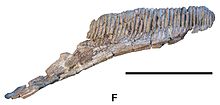Koutalisaurus (meaning "spoon lizard", in reference to the shape of the dentary) is a potentially dubious genus of extinct hadrosaurid dinosaur from the Arenysaurini. It is based on a mostly complete dentary from the Maastrichtian-age Upper Cretaceous Tremp Formation near the town of Abella de la Conca, Lleida, Spain.
| Koutalisaurus Temporal range: Late Cretaceous,
| |
|---|---|

| |
| Right dentary | |
| Scientific classification | |
| Domain: | Eukaryota |
| Kingdom: | Animalia |
| Phylum: | Chordata |
| Clade: | Dinosauria |
| Clade: | †Ornithischia |
| Clade: | †Neornithischia |
| Clade: | †Ornithopoda |
| Family: | †Hadrosauridae |
| Subfamily: | †Lambeosaurinae |
| Tribe: | †Tsintaosaurini |
| Genus: | †Koutalisaurus Prieto-Márquez et al., 2006 |
| Type species | |
| †Koutalisaurus kohlerorum Prieto-Márquez et al., 2006
| |
Discovery and naming
editThe holotype dentary, IPS SRA 27, had previously been referred to Pararhabdodon in 1999,[1] but comes from a different locality, is based on non-comparable material, and has unusual characteristics, leading Prieto-Marquez et al. (2006) to place the dentary in the new species Koutalisaurus kohleorum.[2] Koutalisaurus was later found to be an invalid nomen dubium,[3] although later studies do not reflect this hypothesis and still classify Koutalisaurus as a valid genus.[4]
In 2007, a poster presentation and abstract at a conference suggested many of the hadrosaur specimens found at the Basturs Poble bonebed may have belonged to Koutalisaurus, but they cautioned an adult dentary from the bonebed would need to be discovered to test the hypothesis.[5][3] This idea was later rejected after the Basturs Poble remains were reclassified as belonging to lambeosaurines such as Adynomosaurus and cf. Pararhabdodon.[6][7]
Description
editThe dentary is very elongate, and has a long toothless portion (the front of the jaw, including the end where the predentary would have been attached) that is bent steeply downward and inward, which would have given the jaw a spoon-like shape when complete. It is comparable in size, although on the small side and with unusual proportions (see above), compared to dentaries from other hadrosaurids.[2]
Classification
editPrieto-Marquez et al. (2006) found the animal to be a hadrosaurid, but of uncertain placement within the family.[2] More recent work by Prieto-Marquez and Wagner suggests that it is the same as Pararhabdodon as originally thought.[8]
A 2020 study by Nick Longrich and colleagues describing the genus Ajnabia found Koutalisaurus to be an arenysaurin. The cladogram from their study's phylogenetic analysis is shown below:[4]
| Hadrosauridae |
| ||||||||||||||||||||||||||||||||||||||||||||||||||||||||||||||||||
See also
editReferences
edit- ^ Casanovas, M.L, Pereda-Suberbiola, X., Santafé, J.V., and Weishampel, D.B. (1999). First lambeosaurine hadrosaurid from Europe: palaeobiogeographical implications. Geological Magazine 136(2):205-211.
- ^ a b c Prieto-Marquez, A., Gaete, R., Rivas, G., Galobart, Á., and Boada, M. (2006). Hadrosauroid dinosaurs from the Late Cretaceous of Spain: Pararhabdodon isonensis revisited and Koutalisaurus kohlerorum, gen. et sp. nov. Journal of Vertebrate Paleontology 26(4): 929-943.
- ^ a b Prieto-Márquez, A.; Dalla Vecchia, F. M.; Gaete, R.; Galobart, À. (2013). "Diversity, Relationships, and Biogeography of the Lambeosaurine Dinosaurs from the European Archipelago, with Description of the New Aralosaurin Canardia garonnensis" (PDF). PLOS ONE. 8 (7): e69835. Bibcode:2013PLoSO...869835P. doi:10.1371/journal.pone.0069835. PMC 3724916. PMID 23922815.
- ^ a b Longrich, Nicholas R.; Suberbiola, Xabier Pereda; Pyron, R. Alexander; Jalil, Nour-Eddine (2020). "The first duckbill dinosaur (Hadrosauridae: Lambeosaurinae) from Africa and the role of oceanic dispersal in dinosaur biogeography". Cretaceous Research. 120: 104678. doi:10.1016/j.cretres.2020.104678. S2CID 228807024.
- ^ Prieto-Márquez A, Gaete R, Galobart A, Riera V. (2007). New data on European Hadrosauridae (Dinosauria: Ornithopoda) from the latest Cretaceous of Spain. J Vertebr Paleontol. 27(3): 131A.
- ^ Fondevilla, V.; Dalla Vecchia, F. M.; Gaete, R.; Galobart, À.; Moncunill-Solé, B.; Köhler, M. (2018). "Ontogeny and taxonomy of the hadrosaur (Dinosauria, Ornithopoda) remains from Basturs Poble bonebed (late early Maastrichtian, Tremp Syncline, Spain)". PLOS ONE. 13 (10): e0206287. Bibcode:2018PLoSO..1306287F. doi:10.1371/journal.pone.0206287. PMC 6209292. PMID 30379888.
- ^ Prieto-Márquez, Albert; Fondevilla, Víctor; Sellés, Albert G.; Wagner, Jonathan R.; Galobart; Àngel (2019). "Adynomosaurus arcanus, a new lambeosaurine dinosaur from the Late Cretaceous Ibero-Armorican Island of the European Archipelago". Cretaceous Research. 96: 19–37. Bibcode:2019CrRes..96...19P. doi:10.1016/j.cretres.2018.12.002. S2CID 134582286.
- ^ Prieto-Márquez, A.; Wagner, J.R. (2009). "Pararhabdodon isonensis and Tsintaosaurus spinorhinus: a new clade of lambeosaurine hadrosaurids from Eurasia". Cretaceous Research. online. preprint (5): 1238. Bibcode:2009CrRes..30.1238P. doi:10.1016/j.cretres.2009.06.005. hdl:2152/41080. S2CID 85081036.